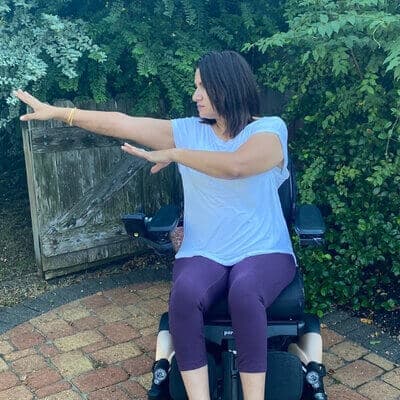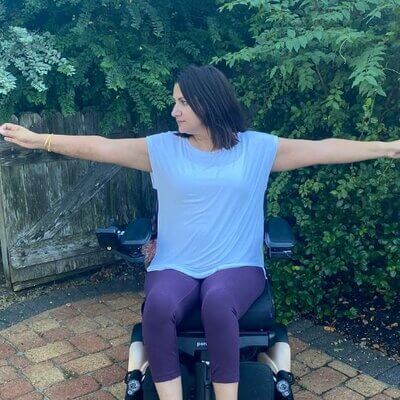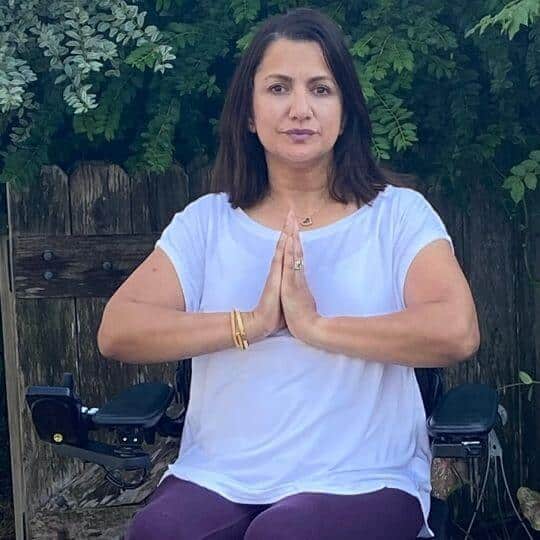Is yoga still possible with a spinal cord injury (SCI)? Yes, depending on each individual’s level of injury. From lifting weights to participating in adaptive sports, people with spinal cord injuries can regularly exercise too.
Adaptive yoga, in particular, can provide both physical and mental benefits to people living with paralysis, whether due to a spinal cord injury, stroke, multiple sclerosis, or another condition.
That’s why I’d like to share some helpful information if you’re looking at starting your own yoga practice post-injury.

Why I Started Practicing Yoga After My Spinal Cord Injury
After my spinal cord injury, I learned that one of the most important things I could do for myself would be to continue to exercise.
Unfortunately, exercising became complicated after I was diagnosed with Myasthenia Gravis, a neuromuscular autoimmune disease that targets muscles and weakens them. These symptoms, including debilitating fatigue, affected my upper body while my spinal cord injury permanently paralyzed both of my legs.
Weight-lifting became more and more difficult for me. I knew I would need to incorporate a type of physical exercise without continuous movement of the same muscles over and over again. Without exercise, I knew the parts of my body that are paralyzed would only deteriorate. Going without exercise could potentially increase my risk of muscle atrophy and other long-term issues common to people with spinal cord injuries like muscle spasms.
After much research and practice, I began a gentle yoga practice that could target my muscles without too much repetition. This helped my muscles stay toned, and the stretching helped increase my flexibility, even in the parts of my body I can not voluntarily move.

How Do I Begin a Yoga Practice With a Spinal Cord Injury?
So how do you start practicing yoga with a spinal cord injury? Anyone can begin with a practice of deep breathing with minimal risk.
However, it’s probably best to talk to your doctor or physical therapist for help with getting started. There are a lot of helpful instructions and videos online as well, including plenty of free instruction on sites like YouTube, so you can potentially practice yoga in the safety and comfort of your own home.
As a paralyzed person, I hold my legs in position and move them gently with my arms in the direction the yoga instruction suggests.
If you have a caregiver, they could potentially seek a demonstration by a physical therapist. This can help you gain the benefits that these simple exercises can offer you.
Reasons to Add Yoga to Your Daily Routine
Curious how practicing gentle stretching, meditation, and/or yoga after your spinal cord injury could benefit you?
Of course, stretching is imperative for anyone, but most especially for someone with limited mobility. Additionally, incorporating breathing exercises helps our minds stay healthy and calm.

Here are a few more reasons to add yoga and meditation to your daily exercise routine.
Improved Mental Clarity and Focus
During yoga, meditation, and basic stretches, it’s a great idea to focus on your breathing. Deep, rhythmic breaths can create a sense of calm, and it also helps more oxygen reach your brain and body.
This may clear your mind and help you focus more on other areas of your life.
Potentially Reduced Symptoms of Depression
Depression can happen to anyone, but those of us with chronic disabilities are often more susceptible to mental health issues like depression and anxiety. According to WebMD, research shows that yoga may help reduce symptoms of depression.
Greater Awareness of Your Body
A gentle yoga practice can help us develop more awareness of our body and how it’s functioning. The more we practice, the more aware we may become. This may even help us identify something that doesn’t feel right and could help with a medical check-up with our doctor.
Reduced Stress
In my opinion, one of the best benefits of practicing adaptive yoga is the management of stress. Stress can impact your life in many ways, including sleep problems, headaches, lack of concentration, and more.
Multiple studies indicate that yoga may help reduce stress and enhance overall well-being.
Improved Strength and Balance
Practicing yoga with a spinal cord injury may help improve your balance, which is especially great if you’re responsible for your own wheelchair transfers. It may help increase your strength and range of motion too.
Personally, I find that yoga has also helped me become more conscious of my posture and my balance.

Yoga Can Be For Everyone
Overall, carefully and mindfully practicing yoga and meditation can deliver an effective, easy way to exercise with a disability.
Of course, you should see your doctor or another qualified healthcare professional and get the okay before beginning any exercise program if you have a spinal cord injury, paralysis of any kind, or another medical condition.
Once you’re ready to begin, you may be surprised to find how yoga can provide many benefits and give much-needed help to our bodies and minds.